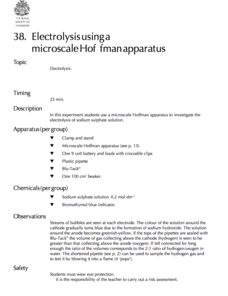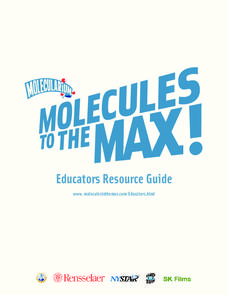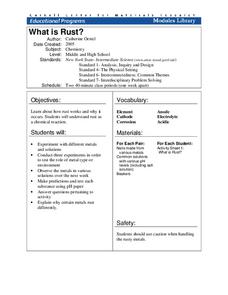Curated OER
Construction of a Microscale Fuel Cell
Fuel cells are being called the "energy source" of the future. Allow your high school chemistry class to construct a miscroscale fuel cell, complete with all components to generate energy. This engaging activity will allow them to apply...
Curated OER
Fuel Cell
Brief, but beneficial, this little gem displays the workings of a hydrogen fuel cell. A simple black-line diagram has question marks at the input and the output, as well as in the middle of the cell. Click on each question mark to reveal...
Curated OER
Aluminum Adventure
Chemistry aces use an electrochemical cell to anodize a strip of aluminum. They apply an organic dye to it. In a practical application, they design a piece of jewelry out of the anodized metal and describe the process. Thorough notes...
Bonneville
Introduction to Circuits
Light up the class's knowledge. Pupils build a simple circuit using a battery, wire, and a light bulb and create a diagram of their circuit. The teacher provides a short lecture on a complete circuit, calling attention to the direction...
Royal Society of Chemistry
Electrolysis Using a Microscale Hoffman Apparatus—Microscale Chemistry
Get big results out of a small-scale lab! Young chemists observe the electrolysis of sodium sulfate using a microscale experiment. A colorful indicator solution combined with the production of gas bubbles yields a variety of observations...
Cornell University
The Galvanic Cell Game
Play a little game with your classes! Young scholars expand on their understanding of oxidation/reduction reactions in a game-based activity. They build a Galvanic cell with game pieces while learning about each component and their...
Cornell University
Splitting Water with Electricity
Explore how electricity splits water molecules into hydrogen and oxygen. Learners begin by calculating the voltage necessary to separate the water. They then perform the experiment and measure the ratio of hydrogen and oxygen bubbles.
Rensselaer Polytechnic Institute
Molecules to the Max!—Educators Resource Guide
From molecules to nanotubes, an engaging unit explores the world of tiny science. Fifteen hands-on experiments and lessons engage young scientists as they learn chemistry. Discussions, worksheets, and data analysis reinforce the concepts...
Cornell University
What Is Rust?
Why do metals rust differently? Scholars experiment with metal combinations in a hands-on activity. They create unique environments with different metals and compare the rate and amount of rust for each.
Cornell University
Electroplating
Silver pennies and copper nickels are made possible by applying some chemistry. Learners use electrolysis to coat a penny with zinc sulfate and a nickel with copper sulfate. Their investigation builds an understanding of electroplating...
Cornell University
Making a Battery
Don't be shocked when your class has a blast making their own batteries! Science scholars examine a dry cell battery, then design and construct a wet cell battery. The activity guides them through the parts of a battery, the variables...
Science Geek
Electrochemistry
Introduce redox reactions including how to identify and solve them. After reviewing the rules for assigning oxidation numbers, a presentation presents trends and vocabulary. Finally, it explains voltaic cells, electrolytic cells,...
Curated OER
Clever Characters for Oxidation and Reduction Concepts
This PowerPoint presents five graphics for helping chemistry scholars to remember the basics of general oxidation and reduction. You will find clever characters, such as An ox to explain that an anode is where oxidation occurs. The...
Curated OER
Electrochemistry Test Review
This review sheet will be very useful to test your pupils' understanding of battery structure and redox reactions. The questions ask for equations to be balanced and for the traditional equipment setups to be drawn and labeled....
Curated OER
A Salt and Battery
In this battery worksheet, learners read about oxidation-reduction reactions and voltaic cells. They are given a diagram of an electrochemical cell and they answer four questions using the cell. They also identify the anode given two...
Curated OER
Spontaneous Cell Reaction
For this spontaneous cell reaction worksheet, students write equations for these types of reactions and determine the voltage associated with the cell. This worksheet has 4 problems to solve.
Curated OER
Review for Chemistry
In this review for chemistry worksheet, students decide if given statements are true or false. Students relate information learned about introductory knowledge gained in chemistry to accurately answer the given questions.
Curated OER
Electrochemistry and Voltaic Cells
In this electrochemistry worksheet, students apply their knowledge as it relates to electrochemistry and voltaic cells. Students write the half-reaction for the anode and cathode. Students calculate the cell potential.
Curated OER
Module 9 Metals
In this chemistry worksheet, students identify and locate various vocabulary terms related to metals found in the periodic table. There are 54 chemistry terms located in the word search.
Khan Academy
Khan Academy: Electrostatics, Medicine, and Metal Spheres
Read a passage about electrostatics and answer the follow-up questions.





















